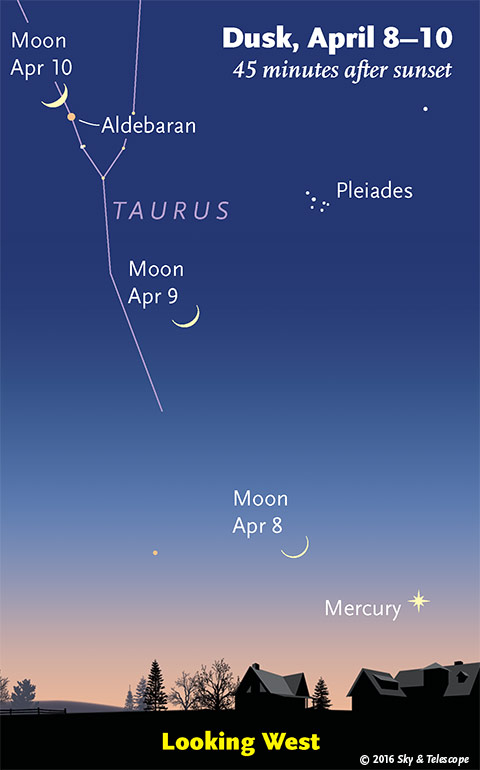
Friday, April 8
• Looking west in twilight, use the thin crescent Moon as your guidepost to Mercury as shown at right.
• Jupiter this evening is just 0.1° north of 5th-magnitude Chi Leonis. Binoculars show the star looking like an out-of-place moon of Jupiter. Compared to this star, a 6-inch telescope may show that Jupiter's moons are not quite pinpoints.
• Have you tried yet for Comet 252P/LINEAR? It's now high in Ophiuchus, excellently placed in a moonless sky in the hour before the first light of dawn. But don't wait, it's leaving! See our current article and chart. As of April 9th it was still hanging in, estimated at magnitude 5.6.
Saturday, April 9
• The crescent Moon shines in the west in twilight. Look for Mercury far down to its lower right. Then as the stars come out, spot Aldebaran to the Moon's upper left and the Pleiades to its upper right, as shown above.
Sunday, April 10
• The crescent moon occults Aldebaran in daylight this afternoon for almost all of North America. Get out the scope for this blue-sky observation (weather permitting). See Crescent Moon To Cover Aldebaran in Blue Sky, with local timetables for the star's disappearance on the Moon's dark limb and reappearance from behind the bright limb.
• After dark, Aldebaran will be shining in the free and clear close to the crescent's bright side for most of North America, as shown above.
Monday, April 11
• The crescent Moon hangs in the west at dusk. As the stars come out, look to the Moon's lower left for Orion, with his belt in its horizontal springtime position.
The belt points left toward bright Sirius, and to the right more or less toward Aldebaran. Right of Aldebaran are the Pleiades.
Tuesday, April 12
• The almost-first-quarter Moon this evening shines in the feet of Gemini — with Pollux and Castor above it, Procyon to its left, and Betelgeuse, the top corner of departing Orion, below it.
Wednesday, April 13
• First-quarter Moon (exact at 11:59 p.m. EDT). The Moon after dusk is positioned between Pollux and Castor to its upper right and Procyon to its lower left (for North America).
Thursday, April 14
• Look left of the Moon this evening for Castor and Pollux. They point more or less back toward it. Below the Moon is Procyon, the Little Dog Star. Much farther below is Sirius, the departing Big Dog Star.
• Bright Arcturus is climbing high in the east these evenings. Equally bright Capella is descending high in the northwest. They stand at exactly the same height above your horizon some time between about 9:00 and 10:30 p.m. daylight-saving time, depending mostly on how far east or west you live in your time zone.
How accurately can you time this event for your location? Like everything star-related, it happens 4 minutes earlier every night.
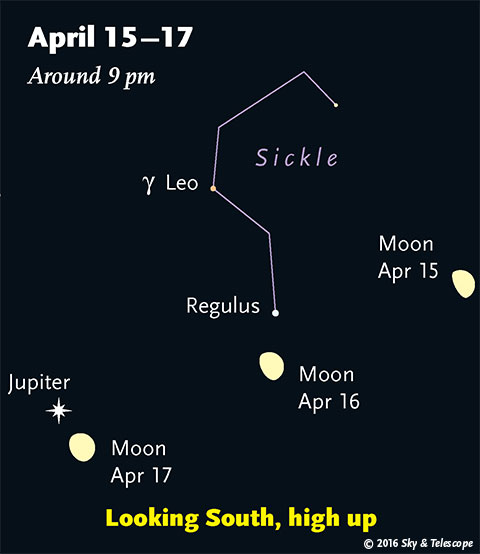
Friday, April 15
• The Moon this evening forms a gently curving row with, to its left, Regulus and then bright Jupiter.
Saturday, April 16
• Look above the Moon after dusk for Regulus, the bottom of the now-vertical Sickle of Leo. They're separated by about 3°, about two finger-widths at arm's length.
_________________________
Want to become a better astronomer? Learn your way around the constellations. They're the key to locating everything fainter and deeper to hunt with binoculars or a telescope.
This is an outdoor nature hobby. For an easy-to-use constellation guide covering the whole evening sky, use the big monthly map in the center of each issue of Sky & Telescope, the essential guide to astronomy.
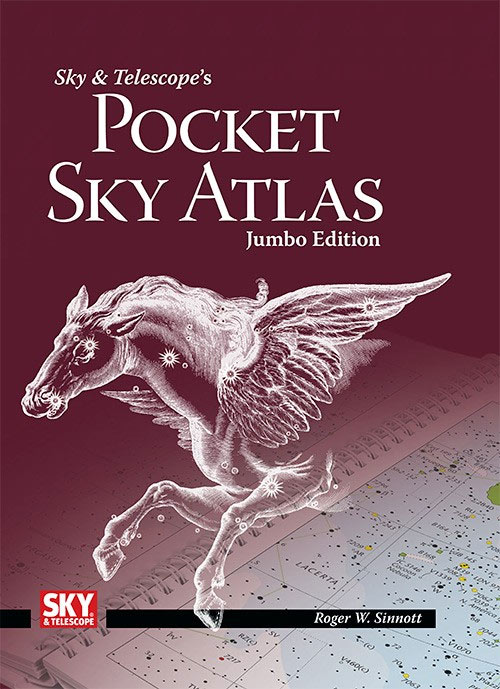
Once you get a telescope, to put it to good use you'll need a detailed, large-scale sky atlas (set of charts). The basic standard is the Pocket Sky Atlas (in either the original or new Jumbo Edition), which shows stars to magnitude 7.6.
Next up is the larger and deeper Sky Atlas 2000.0, plotting stars to magnitude 8.5, nearly three times as many. The next up, once you know your way around, is the even larger Uranometria 2000.0 (stars to magnitude 9.75). And read how to use sky charts with a telescope.
You'll also want a good deep-sky guidebook, such as Sue French's Deep-Sky Wonders collection (which includes its own charts), Sky Atlas 2000.0 Companion by Strong and Sinnott, or the bigger Night Sky Observer's Guide by Kepple and Sanner.
Can a computerized telescope replace charts? Not for beginners, I don't think, and not on mounts and tripods that are less than top-quality mechanically (meaning heavy and expensive). And as Terence Dickinson and Alan Dyer say in their Backyard Astronomer's Guide, "A full appreciation of the universe cannot come without developing the skills to find things in the sky and understanding how the sky works. This knowledge comes only by spending time under the stars with star maps in hand."
This Week's Planet Roundup
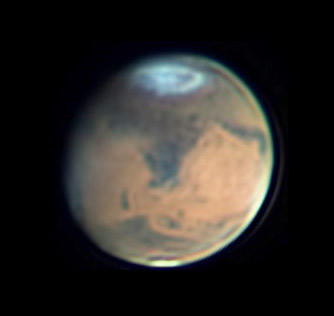
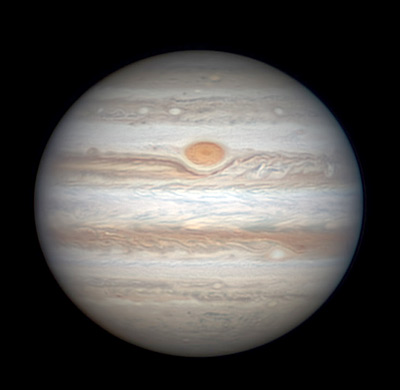
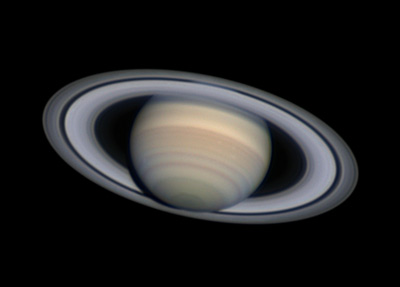
The Sun is displaying an unusually big spot, visible with no magnification — just a safe solar filter or a #13 or #14 rectangular arc-welder's filter. As of Wednesday April 13th the spot, designated AR [Active Region] 2529, had nearly reached the Sun's central meridian. It should remain visible for nearly a week after that, until it rotates around the Sun's western (preceding) limb.
Mercury (bright at about magnitude –0.8) shines in unusually good view in the western twilight this week. Look for it low in the west-northwest in mid-twilight. Each day it appears a little higher. This is Mercury's best evening apparition of the year.
Venus is hidden in the glare of sunrise.
Mars (about magnitude –0.8, in the legs of Ophiuchus above Scorpius), rises around 11 or midnight daylight-saving time. It blazes highest in the south before the first light of dawn, to the right of dimmer Saturn and above Antares. In a telescope Mars grows this week from 13 to 14 arcseconds in diameter. See our telescopic Mars guide in the April issue of Sky & Telescope, page 48.
By the time of its opposition and closest approach in late May, Mars will triple in brightness and grow to 18.6 arcseconds wide.
Jupiter (magnitude –2.4, in southern Leo) dominates the high southeast to south these evenings. Nothing else is nearly so bright! See our telescopic guide to Jupiter in the March issue of Sky & Telescope, page 48.
Saturn (magnitude +0.3, also in the legs of Ophiuchus above Scorpius) rises around midnight 7° or 8° to the lower left of brighter, more colorful Mars. By early dawn they stand in the south-southwest — Saturn on the left, bright Mars on the right. Fainter, Mars-colored Antares beneath Mars makes it a triangle.
Uranus and Neptune are masked by the glow of sunrise.
__________________________
All descriptions that relate to your horizon — including the words up, down, right, and left — are written for the world's mid-northern latitudes. Descriptions that also depend on longitude (mainly Moon positions) are for North America.
Eastern Daylight Time (EDT) is Universal Time (UT, UTC, or GMT) minus 4 hours.
__________________________
“This adventure is made possible by generations of searchers strictly adhering to a simple set of rules. Test ideas by experiments and observations. Build on those ideas that pass the test. Reject the ones that fail. Follow the evidence wherever it leads, and question everything. Accept these terms, and the cosmos is yours.”
— Neil deGrasse Tyson
 1
1








Comments
Jim Cook
April 9, 2016 at 1:04 am
Personal thanks for the April 8 locator for Mercury. I have never found it myself, last seeing it 40+ years ago courtesy of a high school friend. Rereading the entry to confirm what I saw, the identifying of Chi Leonis was icing on the cake. Thanks!
You must be logged in to post a comment.
You must be logged in to post a comment.